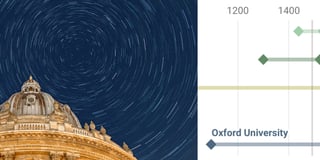The life of a star
Hi there! I’m Pascal, a developer on the Datawrapper app team. Today, we’re not talking about Taylor Swift’s new album, but rather the physical stars in the sky, their quite extreme life, and what they have in common with the famous pop star, you, me, and all of us.
Night skies are beautiful, mainly because of their main attraction: stars, giant balls of hot gas (mostly hydrogen, some helium, and a small amount of other elements). We only get to see a very small subset (a few thousand) of all the 100 billion stars in our galaxy, and of the estimated one septillion (one followed by 24 zeros) in the universe. The main reasons for this are light pollution in cities and the limitations of our eyes, with most stars not bright enough for our eyes to pick up.
Fun fact: if we could see all the stars, the sky would be a very bright beige color, also called Cosmic Latte.
Let’s go through the three phases of a star: birth, life, and death. Naturally, its lifetime depends on a lot of different factors, but it is heavily influenced by its mass, ranging from a few million years for larger stars to trillions of years for the smallest ones.
The nursery
Stars form in giant cold clouds of gas, called molecular clouds, which can be as heavy as 10 million suns and span hundreds of light-years. The low temperature causes gases to clump together, collide with each other, collecting more material until their own gravity causes them to collapse and heat up. With this, a baby star is born, called a protostar. Places with lots of these births are called stellar nurseries.
The steady glow
After living off the energy from heat released during its birth, the real magic begins: nuclear fusion. Due to the enormous pressure and temperature in the core, hydrogen atoms start fusing together, forming helium. This marks the transition from a protostar to a main-sequence star. In this phase, the outward force from nuclear fusion is balanced with the inward pull from gravity, a stable state that the star will be in for most of its life. Our Sun is currently in this phase and will be for another 5 billion years.
The end?
After that, like many stars before, it will have depleted the hydrogen in its core, the essential fuel for nuclear fusion. With the main force counteracting the pull of gravity fading, the core starts to collapse. However, as opposed to some expectations, this will actually cause the star to grow, due to increased pressure and temperatures caused by the squeezing.
What happens next heavily depends on the star’s mass. But as a rule of thumb, the more massive the star, the more brutal (and beautiful!) its final moments.
Very low mass stars (0.08 - 0.6 solar masses), known as red dwarfs, are the most common type of star and very thrifty at burning fuel. So much in fact, that no red dwarf has ever died. The universe is simply not old enough for any of them to have run out of hydrogen. They will simply shrink and cool down, eventually becoming a helium white dwarf.
Low mass stars like our Sun (0.6 - 8 solar masses) are a bit more dramatic. They will swell into a red giant about 200 times their size. In our Solar system, this process will most likely kill planets, like Mercury, Venus, and even Earth, once they’re vaporized by the giant Sun.
Over time, the stars’ outer layers will be ejected and drift away, creating an expanding cloud of dust, a planetary nebula like this:

The core remains as a very dense white dwarf, which no longer produces energy through fusion. So over a period of trillions of years, it will slowly cool down and fade, eventually turning into a cold black dwarf.
High mass stars (8 - 20 solar masses) will get so hot they will start fusing less efficient elements, extending their lifetime by smaller increments every time. Until they arrive at iron, which consumes energy rather than releasing it. Once this happens, gravity wins and the core collapses in less than a second, resulting in a supernova explosion. An explosion so powerful that heavy elements like gold and uranium are forged, which are then scattered across the galaxy. The core itself remains as an incredibly dense neutron star, hundreds of thousands of times smaller than the original. To put this into perspective, this is like turning a football stadium into a marble.
Very high mass stars (> 20 solar masses) only live a few million years and have a very similar life and death to high mass stars. The ‘tiny’ difference being that the resulting core is too heavy to become a stable neutron star. Instead, it collapses entirely into a singularity, an infinitely small and infinitely dense point in space forming a black hole, from which even light cannot escape. (Another fun fact: when falling into a black hole, this point in space becomes a point in time, which is a fascinating topic but definitely something for another Weekly Chart.)
You’re a star too!
Or at least you used to be. Everything you see around you and all the elements that you’re made of (besides hydrogen and helium) have been forged in the core of a star and scattered across the universe by supernova explosions a few billion years ago. Or like Carl Sagan put it: “We’re all made of starstuff.”
Thank you for reading this far. I hope you learned something new, and I was able to share some of my fascination for the universe and the violent and beautiful processes that shape it. Next week you’ll hear from a fellow member of the app team, Jack.



